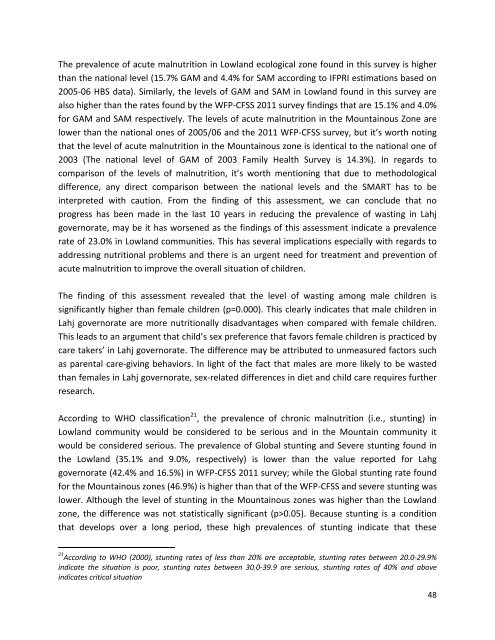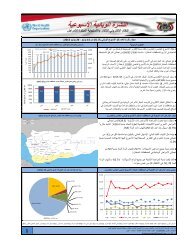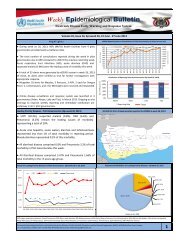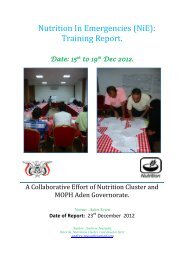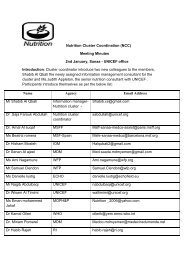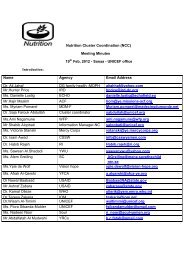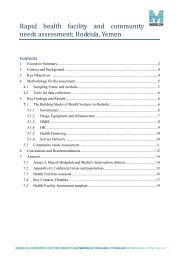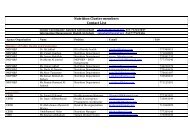Download - Yemen Humanitarian Response | YEMEN
Download - Yemen Humanitarian Response | YEMEN
Download - Yemen Humanitarian Response | YEMEN
You also want an ePaper? Increase the reach of your titles
YUMPU automatically turns print PDFs into web optimized ePapers that Google loves.
The prevalence of acute malnutrition in Lowland ecological zone found in this survey is higherthan the national level (15.7% GAM and 4.4% for SAM according to IFPRI estimations based on2005-06 HBS data). Similarly, the levels of GAM and SAM in Lowland found in this survey arealso higher than the rates found by the WFP-CFSS 2011 survey findings that are 15.1% and 4.0%for GAM and SAM respectively. The levels of acute malnutrition in the Mountainous Zone arelower than the national ones of 2005/06 and the 2011 WFP-CFSS survey, but it’s worth notingthat the level of acute malnutrition in the Mountainous zone is identical to the national one of2003 (The national level of GAM of 2003 Family Health Survey is 14.3%). In regards tocomparison of the levels of malnutrition, it’s worth mentioning that due to methodologicaldifference, any direct comparison between the national levels and the SMART has to beinterpreted with caution. From the finding of this assessment, we can conclude that noprogress has been made in the last 10 years in reducing the prevalence of wasting in Lahjgovernorate, may be it has worsened as the findings of this assessment indicate a prevalencerate of 23.0% in Lowland communities. This has several implications especially with regards toaddressing nutritional problems and there is an urgent need for treatment and prevention ofacute malnutrition to improve the overall situation of children.The finding of this assessment revealed that the level of wasting among male children issignificantly higher than female children (p=0.000). This clearly indicates that male children inLahj governorate are more nutritionally disadvantages when compared with female children.This leads to an argument that child’s sex preference that favors female children is practiced bycare takers’ in Lahj governorate. The difference may be attributed to unmeasured factors suchas parental care-giving behaviors. In light of the fact that males are more likely to be wastedthan females in Lahj governorate, sex-related differences in diet and child care requires furtherresearch.According to WHO classification 21 , the prevalence of chronic malnutrition (i.e., stunting) inLowland community would be considered to be serious and in the Mountain community itwould be considered serious. The prevalence of Global stunting and Severe stunting found inthe Lowland (35.1% and 9.0%, respectively) is lower than the value reported for Lahggovernorate (42.4% and 16.5%) in WFP-CFSS 2011 survey; while the Global stunting rate foundfor the Mountainous zones (46.9%) is higher than that of the WFP-CFSS and severe stunting waslower. Although the level of stunting in the Mountainous zones was higher than the Lowlandzone, the difference was not statistically significant (p>0.05). Because stunting is a conditionthat develops over a long period, these high prevalences of stunting indicate that these21 According to WHO (2000), stunting rates of less than 20% are acceptable, stunting rates between 20.0-29.9%indicate the situation is poor, stunting rates between 30.0-39.9 are serious, stunting rates of 40% and aboveindicates critical situation48


